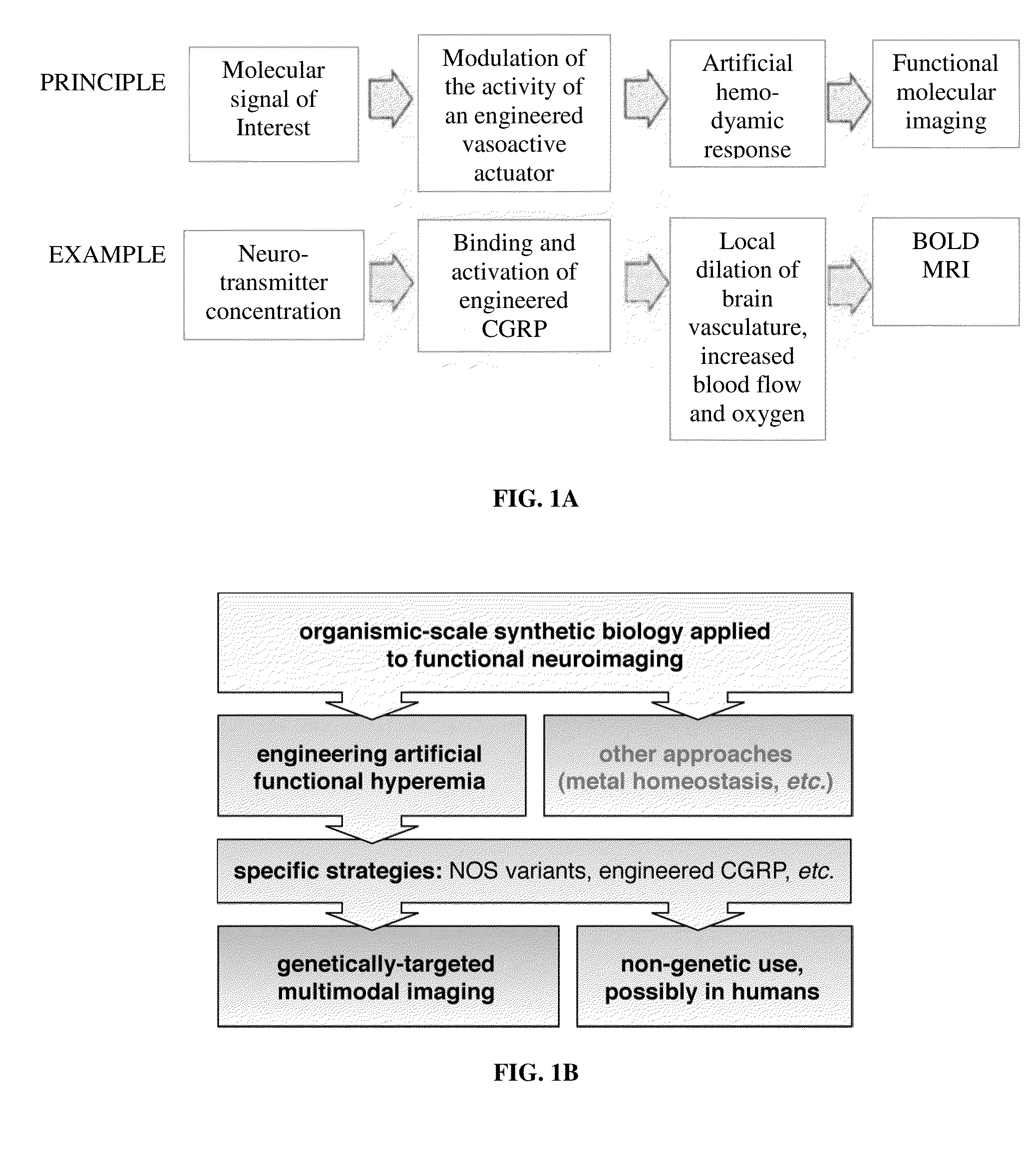Molecular and cellular imaging using engineered hemodynamic responses
a hemodynamic response and molecular imaging technology, applied in the direction of enzymology, peptides, spectroscopy, etc., can solve the problems of complicated experiments, difficult to deliver past the blood-brain barrier, and perturbation of normal biological function
- Summary
- Abstract
- Description
- Claims
- Application Information
AI Technical Summary
Benefits of technology
Problems solved by technology
Method used
Image
Examples
example 1
Molecular Functional Imaging Using Engineered Neuropeptides
[0113]Calcitonin gene-related peptide (CGRP) is a 37 amino acid, vasoactive neuropeptide which is secreted by neurons and effects dilation of the microvasoulature by binding to a heterodimeric, G-protein coupled receptor on the surface of endothelial cells. CGRP is a potent peptidic vasodilator, with half-maximal effect at a concentration below 10 nM.
[0114]CGRP receptors are expressed inside the brain and in the presence of an intact BBB, intravenously injected CGRP has no detectable vasodilatory effect in the brain vasculature. Disruption of the BBB by traumatic injury, carcinogenesis, or inflammation renders it penetrable by CGRP. Thus, BOLD MRI following systemic CGRP injection may be used to detect BBB disruption.
[0115]Other vasoactive peptides used include engineered adrenomedullin (ADM) and especially engineered Maxadilan (Max), a vasoactive peptide from the salivary glands of sandflies which causes vasodilation in mam...
example 2
Molecular Functional Imaging Using Engineered NOS
[0118]Nitric oxide synthase (NOS) is an intermediary in the hyperemic response, and exists in several isoforms which differ in their responsiveness to regulatory factors.
[0119]In this example, a strategy is provided for molecular functional imaging of the brain using engineered NOS. An engineered chimera is produced that has a catalytic domain of inducible NOS (NOS) and of the regulatory domain of neuronal NOS (nNOS). The chimera exhibits dependence on calcium-bound calmodulin (Ca4CaM) as conferred by the nNOS regulatory domain, and independence of certain synthetic, BBB-permeable inhibitors with specificity for the nNOS catalytic domain such as 7-nitroindazole (7-NI).
[0120]Using the chimeras, neural activity and calcium release is related to NOS activity by (i) inhibition of endogenous nNOS activity using systemic administration of 7-NI and (ii) calcium-dependent activation of the nNOS-iNOS chimeras. Imaging of the resulting hemodyna...
example 3
A CGRP-Based Molecular Sensor
[0126]A CGRP-based molecular sensor for neurotransmitter concentrations is constructed as a fusion protein comprising a neurotransmitter analog, CGRP, and a binding domain such that the interaction between the binding domain and the analog disrupts CGRP function. In the presence of the neurotransmitter of interest, the free neurotransmitter is bound by the binding domain instead and CGRP function is (reversibly) restored. Thus, vasodilation is induced in response to the neurotransmitter with spatial and temporal specificity and recorded by optical or magnetic resonance imaging.
[0127]CGRP reporter cells were created by lentiviral transduction of HEK293FT cells with genes encoding the heterodimeric CGRP receptor, comprised of human CALCRL and RAMP1, and a luminescent reporter. HEK293FT cell lines carrying the following lentiviral constructs were used:
(SEQ ID NO: 16)pEXPR-T7-cfSGFP2-Linker-Cleavage-Site-CGRP-Gly (SEQ ID NO: 17)pLV-hEF1a-GLo22F-IRES-H2B-Ceru...
PUM
| Property | Measurement | Unit |
|---|---|---|
| Flow rate | aaaaa | aaaaa |
| Concentration | aaaaa | aaaaa |
| Sensitivity | aaaaa | aaaaa |
Abstract
Description
Claims
Application Information
 Login to View More
Login to View More - R&D
- Intellectual Property
- Life Sciences
- Materials
- Tech Scout
- Unparalleled Data Quality
- Higher Quality Content
- 60% Fewer Hallucinations
Browse by: Latest US Patents, China's latest patents, Technical Efficacy Thesaurus, Application Domain, Technology Topic, Popular Technical Reports.
© 2025 PatSnap. All rights reserved.Legal|Privacy policy|Modern Slavery Act Transparency Statement|Sitemap|About US| Contact US: help@patsnap.com



